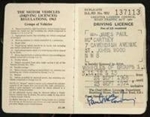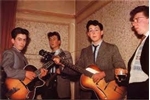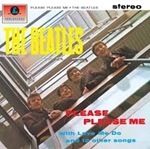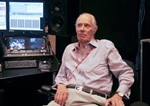- Register
- Log in to Tune-In
- Wishlist (0)
-
Shopping cart
(0)
You have no items in your shopping cart.
Beatles News

Ringo Starr left the Maharishi Mahesh Yogi’s Rishikesh ashram earlier than his bandmates in 1968 – as might be expected from a ring-wearing dandy who many would assume was the least spiritual of all the Beatles. He had found meals at the ashram difficult, not because he was a Liverpudlian naïf abroad, but because a childhood of serious ill health had left his insides in a delicate state. Plus, his wife Maureen hated the insects. After less than a fortnight, they were out.
Starr was the band’s everyman, a seasoned pro sent aloft into stratospheric fame where his ready grin and quick wit made him an easy favourite Fab. And yet – in one of the revelations of Tom Doyle’s thoroughly researched book – it turns out that his habitual “peace and love” refrain isn’t just some rote catchphrase. It runs deeper. In recent years, since undergoing rehab in 1988, Starr has become a paragon of clean living, regularly snacking on seeds and, allegedly, smelling of kale. Crucially, he has said that he still treasures the personal mantra for meditation that the Maharishi gave him all those years ago.
Doyle’s portrait doesn’t exactly dismantle the public perceptio details

How did The Beatles do it? How did they get from the simplicity of “Love Me Do”, their first hit single, to majestic, complex, moving songs like “Strawberry Fields Forever”, “Blackbird”, “Within You Without You”, and so many more? Well, they didn’t get there overnight. These four songs represent huge developmental leaps that eventually led to the masterpieces from the second half of their recording career.
On the surface, you might not consider “She Loves You” to be all that complex. But it subtly shows that the Fab Four understood that they couldn’t stand pat if they wanted to stay on top of the heap. Granted, it was another basic love song in content. But Paul McCartney came up with the idea to change the approach ever so slightly. Instead of singing the song from the first-person perspective (as in, “I love you”), the group did it in the third person. That means the narrator technically is just offering advice, which was a somewhat novel twist at the time. In addition, The Beatles snuck in some chord changes that were far from the norm for the typical early 60s pop song.
“I Need You”
Again, here’s an exa details

Paul McCartney's driver's license from the late 1960s is to go on sale - and is expected to fetch up to £1,200.
The old-style UK Driving Licence features the Beatle's signature as well as two fines for road offences committed in Coventry and Bath.
The license will be auctioned at Ewbank’s Music Memorabilia sale next month, and is expected to fetch between £800 and £1,200.
McCartney's license, in red cloth-covered board and in a red ‘Cartier International Services’ pouch, lists the musician’s name as Mr. James Paul McCartney. His address is listed as '7 Cavendish Avenue St. Johns Wood NW8' and is valid from '24 Sept 1968 until 23 Sept 1971'.
The license has Paul's signature in blue felt pen at the bottom.
Source: Talker News/nbcrightnow.com
details
In 1973, George Harrison soured the mood at a pre-Christmas get-together at Ringo Starr’s place by fessing up to an affair with the drummer’s wife Maureen. The man Eric Morecambe called Bongo responded with a shrug: “Better you than someone we don’t know.”
This charming biography casts Starr as The Beatles’ anchor emotionally as well as rhythmically, showing how he overlooked bandmates’ foibles to maintain the Fabs’ team spirit beyond their 1970 split. Richy Starkey took up drumming while recovering from a teenage bout of tuberculosis, a no-nonsense persona underselling his unique playing style. MOJO writer Tom Doyle tracks how he became America’s favourite Beatle and then a solo hitmaker before bad film roles, a messy divorce and a worse alcohol problem took their toll. Sober since the 1980s, Starr’s drum-roll-with-the-punches resilience persists; as he told Doyle in a typically gnomic interview: “I make more right moves than left moves.” Resolutely fab.
Source: Jim Wirth/mojo4music.com
details

Before The Beatles became the biggest band in the world and the most successful rock band of all time, they were just like every other group of friends with musical dreams. Paul McCartney, John Lennon, and George Harrison all met through a series of introductions taking place on buses and at garden parties. And by the time 1958 came along, they were all members of the same band, The Quarrymen.
3 Classic Rock Songs With Unnecessary Guitar Solos
As The Quarrymen, Lennon, Harrison, and McCartney did the typical—performed at churches, clubs, schools, as well as other informal non-traditional venues. They played a mix of skiffle, rock and roll, and rockabilly music, and they covered American artists such as Buddy Holly, Elvis Presley, Carl Perkins, and Larry Williams.
However, at some point in 1958, they recorded their first-ever original song. An original song written by George Harrison and Paul McCartney about friendship and love in the face of everything that can go wrong. For a couple of teenagers, it is quite the introspective and sentimentally deep songs, but then again, and despite their normalness, these were The Beatles.
The Beatles’ Quick Trip to a One-Room Recording Studio

Creating timeless artistic masterpieces is no easy feat. However, what makes a masterpiece a masterpiece in part is the work and the labor that goes into it. The work and the labor that drives the artist in question to the brink of madness. As history tells us, Glory is often gifted to those who grind through the process, and it was gifted to John Lennon after he toiled with “Across The Universe”.
John Lennon is one of the greatest songwriters of all time. He might not be your personal favorite, but you can’t deny him that. While Lennon certainly had an innate compassion and connection with the human condition and a knack for words, he didn’t garner this unofficial title of pure ability. According to this story, and others, Lennon acquired this title in the same way many others have acquired greatness—Through hard work. John Lennon’s “Across The Universe” Started Far Before ‘Let It Be’
The writing process started far before the release of The Beatles’ final album, Let It Be. Specifically, Lennon started writing the single while he was still with his first wife, Cynthia Lennon. In the book, All We Are Saying, John Lennon was quoted as st details

The band is widely seen as one of the biggest influences on modern popular and rock music, and culture.
Fans named the greatest classic rock band in a 2025 Ranker poll. They revolutionized music, influenced culture, and sold over 600 million records worldwide. Their music continues to inspire, with hits often covered and sampled by diverse artists.
The Beatles revolutionized popular music and influenced 1960s counterculture, selling over 600 million records worldwide, but now the original boy band can add one more accolade to their long list of superlatives. According to a recent poll, The Beatles are also the greatest classic rock band of all time, besting the likes of Led Zeppelin, Pink Floyd, The Rolling Stones, and Queen.
According to an October 2025 Ranker poll, fans think The Beatles are the greatest classic rock band of all time. Ranker, which ranks all things pop culture, starts out with a list curated by experts. Once the list is published, fans get to work, voting the list’s picks up or down. The Beatles top the site’s list of greatest classic rock bands of all time with over 20,000 votes.
Impact and Legacy
The Beatles began as the band The Quarrymen, then The Silv details

When a famous musician passes away, the whole world mourns. While we, as listeners, certainly feel the loss, it’s nothing compared to how their bandmates feel. Bands, if they are lucky, spend decades together in a larger-than-life circumstance. It builds a relationship that is unlike anything else in life. Moreover, they express their grief in a way no one else does: through song. Below, find four touching tribute songs written by artists for their late bandmates.
“All Those Years Ago” – George Harrison and John Lennon
Like much of the world, George Harrison felt very reflective after the murder of John Lennon. At least, that’s what his songwriting suggests. Despite their issues towards the end of the Beatles‘ tenure, Harrison looked back fondly on his late bandmate, penning the song “All Those Years Ago” as a tribute to him.
Living with good and bad / I always looked up to you / Now we’re left cold and sad / By someone, the devil’s best friend / Someone who offended all, the lyrics read. Though this song was initially written for Ringo Starr, Harrison managed to rework it into the perfect eulogy for Lennon.
Kurt Cobain’s death is details

Bob Dylan and the Beatles had a memorable 1964 hotel meeting. Dylan’s misunderstanding of a Beatles' song lyrics prompted a 'surreal' evening. John Lennon and Paul McCartney later shared fond memories of the experience.
It goes without saying that Bob Dylan is one of the most influential musicians in history, as anyone with a passing familiarity of rock history knows. But the folk-rock icon’s impact on his peers goes beyond chord structure and lyrical composition, as one particularly entertaining anecdote from the annals of rock history involving the Beatles proves.
In August of 1964, the Beatles were staying at the Delmonico Hotel near Manhattan’s Central Park, according to the Beatles Bible, digging into a room service dinner, when Dylan showed up for a visit.
After being introduced to the band by a mutual friend, the writer Al Aronowitz, Dylan was offered some champagne…but apparently, he preferred “cheap wine” instead. Since there wasn’t any budget booze on hand, Dylan suggested they “smoke grass” instead. When the Beatles’ manager, Brian Epstein, admitted that the band didn’t have much experience with marijuana, details

The Beatles’ debut album was an attempt to capture the band’s live appeal, according to John Lennon.
Please Please Me would be released in March 1963 and was a chance for the band to showcase their skills as a touring unit. Lennon would share the thought process behind recording Please Please Me as a way to “capture The Beatles live” in interviews given shortly after the album was released. Lennon suggested Please Please Me is the closest the Fab Four could get to capturing the essence of their live performance, though even that was missing the atmosphere of the Hamburg and Liverpool audiences. Producer George Martin had initially suggested the band record a live album as their debut release at The Cavern Club in Liverpool, though these plans would fall through. Instead, the band recorded studio album Please Please Me as an opportunity to highlight their live appeal.
Lennon said: “That record tried to capture us live, and was the nearest thing to what we might have sounded like to the audiences in Hamburg and Liverpool. You don’t get that live atmosphere of the crowd stomping on the beat with you, but it’s the nearest you can get to knowing what we sounded like before we details

It's been nine years since the tragic demise of music producer George Martin, best known for his groundbreaking work with The Beatles. Those included Paul McCartney, John Lennon, George Harrison, and Ringo Starr. Martin worked so closely with the famed British band that he was frequently nicknamed the "fifth Beatle." He died of undisclosed causes on March 8, 2016. Martin was 90 years old, and this is his story.
George Martin was born on January 3, 1926, in Highbury, United Kingdom.
From Please Please Me, the Beatles' initial collected work (released in 1963) to their Abbey Road album (released in 1969), Martin worked diligently with the so-called 'Fab Four' to perfect the unique sound and elements of each of their compositions.
Following the band's dissolution, Martin produced for Paul McCartney and Ringo Starr on their solo albums, specifically McCartney's James Bond movie track release Live and Let Die (1973).
Martin also worked closely with additional music icons such as Kenny Rogers, Celine Dion, Elton John, and more.
On March 8, 2016, Martin passed away quietly in his sleep.
Source: Herbie J Pilato/newsbreak.com
details
George Harrison was a stoic and quiet individual. He had no shortage of talent both in The Beatles and as a solo artist, and the latter of which was (in my opinion) where he truly shone. He wasn’t the big smack-talker, either. But George Harrison did have a few choice words for some of his musician contemporaries, and even disliked a few famous bands and musicians. Let’s look at a few examples, shall we?
Oasis
I’ll be honest, I was surprised to see this band mentioned in my research for this list of musicians that George Harrison famously disliked. Oasis? Really? A lot of people had some choice words for the Britpop band back in the day, but I wouldn’t have thought George Harrison, formerly of The Beatles, would be paying attention to them, specifically.
Well, it appears that this one is true, and George Harrison was not a big fan of Oasis in the 1990s. In fact, in 1996, Harrison pretty directly said that their music “lacks depth” and that “singer Liam [Gallagher] is a pain, the rest of the band don’t need him.” Ouch. No wonder Gallagher threatened to punch him.
Sex Pistols
The Beatles, in a roundabout way, were pretty punk rock for th details

James Norton to Play Beatles Manager Brian Epstein in Sam Mendes’ Groundbreaking Biopic Series
Happy Valley actor James Norton is reportedly stepping into the shoes of the man behind the Beatles’ meteoric rise: Brian Epstein. The casting, yet to be officially confirmed, is for Sam Mendes’ unprecedented four-film biopic series chronicling the lives of the Fab Four.
Norton would portray Epstein, the shrewd and stylish manager who discovered the Beatles in a Liverpool basement club in 1961 and guided them to global superstardom before his tragic death in 1967. His role is pivotal to the Beatles’ origin story — and the films are aiming for just that: the full picture.
Announced in 2024, Mendes’ project will present four interwoven narratives, each from the perspective of a different Beatle. It marks a historic moment in music cinema, as Apple Corps has for the first time granted full life story and music rights for such a project.
Slated for a 2028 release, the biopics will star a dynamic ensemble:
Paul Mescal as Paul McCartney
Harris Dickinson as John Lennon
Barry Keoghan as Ringo Starr
Joseph Quinn as George Harrison
The behin details

When Carole King made the rounds introducing herself to all four of The Beatles at a party at the Warwick Hotel in New York City, the songwriter came face to face with each musician’s unique personalities (and reputations): Paul McCartney was affable and chatty, George Harrison was quiet but polite, Ringo Starr “was Ringo,” and John Lennon was snarky to the point of being downright rude.
At the time, King didn’t press Lennon to see if his behavior was actually directed toward her or if she was an unfortunate but unintentional victim of one of his sulkier moods. She was hardly a nobody at the party, after all. Even McCartney stopped to tell her what a great influence she and her songwriting partner, Gerry Goffin, were to him. But at 23 years old, getting blown off by one of the biggest rockstars in the world was going to sting, no matter how many hits she had under her belt.
During a 2012 interview at the John F. Kennedy Presidential Library and Museum, King described the memorable moment. Lennon was the last Beatle she had to introduce herself to. “He’s standing with two women, neither of whom was Cynthia [Lennon, his first wife]. He looks high; he looks like he’s totall details

For some people, an album is simply a collection of singles and a few fillers and nothing more. Paul McCartney, however, is an artist who typically considers his work more carefully. He and the Beatles helped define the modern album—work that seems to expand the bounds of what an album was in the decades before their rise to fame. Because of this, McCartney fans were shocked when he made an album full of what he called “throwaways.” Find out which album that was below.
McCartney’s writing always stood in stark contrast to his bandmates’. By the end of their tenure, the band had all but given up on McCartney’s whimsical songwriting voice. To pursue that creative ambition, he needed to shed the weight of the other Beatles.
Though he got his wish, it wasn’t as easy a road as he might have thought before the band broke up. Of course, changing gears might have seemed like heaven to McCartney in the middle of the Beatles’ tenuous relationship, but finding solo success was almost equally as hard.
Fans wanted more of the same, which they couldn’t have after the Beatles parted ways. In hindsight, it would’ve been impossible to please everyone with a debu details
